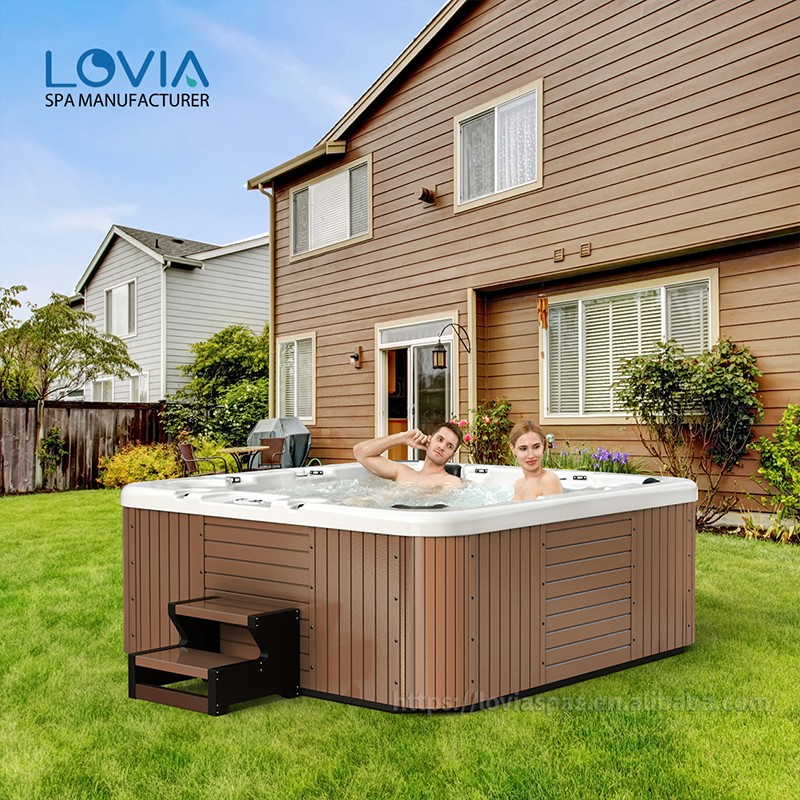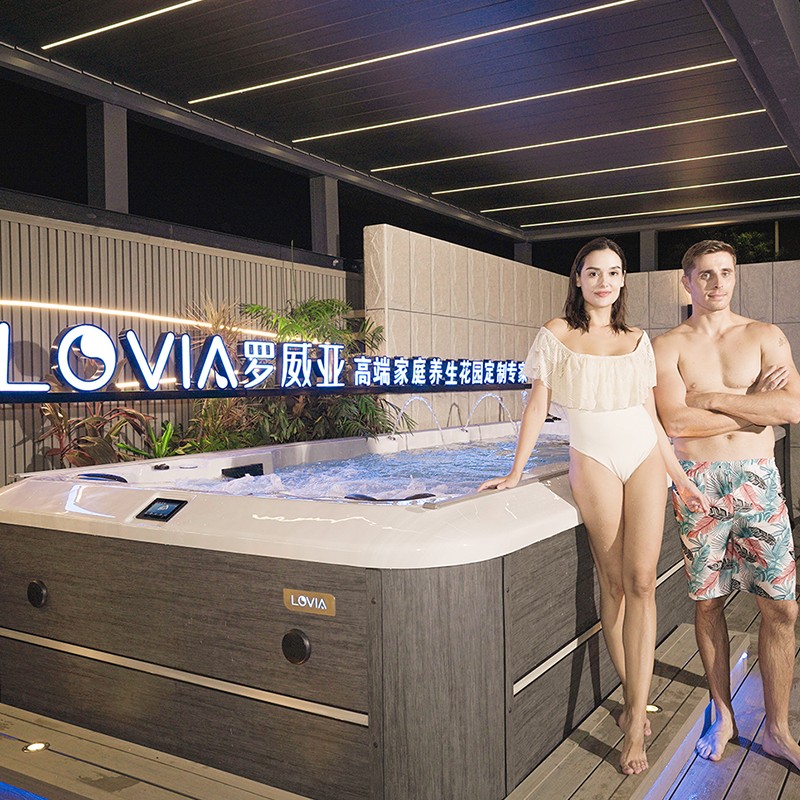
How can you make your outdoor hot tub more insulated?
2025-01-04 15:30Outdoor hot tubs are a great choice for many families because of their comfort and relaxation effects. However, maintaining the water temperature of a hot bathtub, especially in cold weather, is often a challenge. If the insulation is not good, not only will the water temperature of the tub drop rapidly, increasing the consumption of hot water and electricity, but it may also shorten the life of the tub. Therefore, improving the insulation of an outdoor hot tub can not only improve comfort, but also save energy and maintenance costs.
This article will explore how to improve the insulation of an outdoor hot tub through reasonable design, material selection and maintenance from many aspects.

What is the importance of hot bathtub insulation?
Outdoor hot tubs are exposed to the natural environment for a long time and are inevitably affected by temperature changes. Whether it is the high temperature in summer or the cold in winter, it may have an adverse effect on the water temperature. Good insulation can effectively reduce heat loss and maintain the stability of the water temperature in the tub.
Reduce energy consumption
If the hot tub is not well insulated, the water temperature will drop quickly, causing the heating system to work frequently, thereby increasing the consumption of electricity or gas. By improving the insulation effect, the bathtub can maintain a constant water temperature, reduce energy loss and reduce the cost of use.
Extend the life of the equipment
When the heating system operates for a long time and at a high frequency, it will accelerate its wear and shorten the service life of the equipment. Good insulation design can reduce the burden on the heating system and extend the life of the equipment.
Improve user experience
Good insulation can ensure that the hot tub still maintains the ideal water temperature in different weather conditions, especially when used in winter, without affecting comfort due to rapid heat loss.

How to make the outdoor hot tub better insulated?
The quality of insulation depends largely on the insulation material used in the hot tub itself. The type and quality of the insulation material will directly affect the insulation capacity of the bathtub.
1. Selection of foam material
Many high-quality outdoor hot bathtubs use polyurethane foam or similar foam materials as the main insulation material. Polyurethane foam has excellent thermal resistance and can effectively prevent heat from being lost through the outer shell of the bathtub. To ensure the best insulation effect, it is recommended to choose a material with a higher foam density, which can provide stronger insulation performance.
2. Multi-layer insulation structure
High-end outdoor hot tubs usually use multi-layer insulation structure, which can significantly improve the insulation effect. For example, using multiple layers of insulation boards, foam fillings and insulation fibers between the outer wall and the interior of the tub can not only block heat loss, but also effectively prevent cold air from invading the tub.
3. Bottom insulation
Bottom insulation is also an important part of the insulation performance of outdoor hot bathtubs. A lot of heat is transferred to the ground through the bottom of the tub. Therefore, installing insulation pads or using special insulation materials at the bottom can reduce this part of heat loss.
Use of hot tub covers
Hot tub covers are one of the most direct and effective tools to maintain the water temperature and insulation effect of the tub. A high-quality tub cover can reduce heat loss by up to 75% when the tub is not in use. Therefore, choosing a suitable cover and using it correctly is the key to improving the insulation effect.
Choose a thick cover
The thickness of the hot bathtub cover directly affects its insulation ability. Generally, a cover with a thickness of 3 to 5 inches can provide good insulation. In addition, the material filled in the cover is also crucial, and covers filled with polyurethane foam are particularly good at insulating.
Ensure the tightness of the cover
Whether the edges of the hot bathtub cover can be tightly sealed will directly affect the retention of heat. If there are gaps in the edges of the cover, heat can easily escape from these gaps. To ensure the tightness of the cover, users can choose a cover with a thickened edge or an additional sealing strip design.
Check the wear of the cover regularly
Over time, the hot tub cover may age and break due to the influence of sunlight, rain or other environmental factors. The aging cover not only reduces the insulation effect, but also absorbs water, which accelerates heat loss. Therefore, regularly checking the status of the cover and replacing it with a new one when necessary is a key step in maintaining the insulation effect of the bathtub.

Reduce heat conduction and convection
Heat loss occurs not only through conduction, but also through air convection. If the hot tub is exposed to strong winds and low temperatures, the rate of heat loss will be greatly accelerated. To reduce heat loss caused by convection, the following measures can be taken:
Build a barrier
Build a physical barrier around the hot tub, such as a fence, windshield or plant barrier, which can effectively reduce the direct impact of strong winds on the tub, thereby reducing heat loss. Especially when used in cold areas or in winter, the windshield design around the tub can significantly improve the insulation effect of the tub.
Use of outdoor shelters
Building a shelter or pavilion for the outdoor hot tub can not only block the sun and prevent the water temperature from being too high, but also keep the water warm in winter and reduce the invasion of cold air. The shelter can be a fixed trellis or a movable curtain or baffle. Choose the appropriate solution according to actual needs and environment.
Reduce the opening time of the tub
Every time you use the hot bathtub, a lot of heat will be lost quickly after opening the lid. Therefore, try to shorten the opening time and close the lid in time after use, which can effectively reduce heat loss.
Temperature control and heater optimization
While improving the insulation effect, correct temperature control and heater optimization are also important links to ensure the insulation performance of outdoor hot tubs.
Set the right water temperature
The ideal temperature for a hot tub is usually between 100°F (37.8°C) and 104°F (40°C). However, when not in use, the water temperature can be lowered to between 80°F (26.6°C) and 90°F (32.2°C), which can reduce the frequency of the heater's operation and save energy. If the weather is cold, you can slightly increase the water temperature, but do not raise the temperature too much to avoid increasing heat loss.
Use efficient heaters
Using efficient and energy-saving heaters is another way to improve the insulation of your hot tub. Modern efficient heaters can heat the water temperature quickly and automatically adjust the working mode when not in use to reduce unnecessary energy consumption. Users can consult a professional to choose the right heating system based on the specifications and needs of the bathtub.
Regularly maintain the heater
The performance of the heater is crucial to the insulation of the hot tub. Regularly checking the working status of the heater to ensure that it is operating in optimal conditions can effectively improve the heating efficiency of the hot water. In addition, clean the scale and impurities on the heater to prevent it from affecting the heating speed due to long-term use.
Choose a suitable installation location
The installation location of the hot bathtub also plays a vital role in improving the insulation effect. If the outdoor environment is extremely harsh, it is difficult to completely avoid heat loss even with the best materials and equipment. A reasonable installation location can provide natural protection for the bathtub and reduce heat loss.
Avoid wind vents and shaded areas
Try to install the hot bathtub in a windproof area, such as near a building or fence, so as to reduce the direct impact of wind on the bathtub water surface and reduce heat loss. In addition, choose a sunny place to install the bathtub. In winter, solar energy can be used to help increase the water temperature and reduce the burden on the heating system.
Use insulation pads
In cold areas, installing the bathtub directly on the ground may cause a lot of heat to be lost through the ground. Using efficient insulation pads, especially in cold environments, can effectively prevent heat from being transferred from the bottom of the bathtub to the ground, thereby improving thermal insulation performance.
With certifications like CE and ISO9001, Lovia Spa guarantees superior quality in every product we deliver. Our energy-efficient hot bathtubs, swim spas, and advanced heat pumps are perfect for creating serene wellness spaces. Partner with us to access factory promotions, customized services, and expert support for your business.
